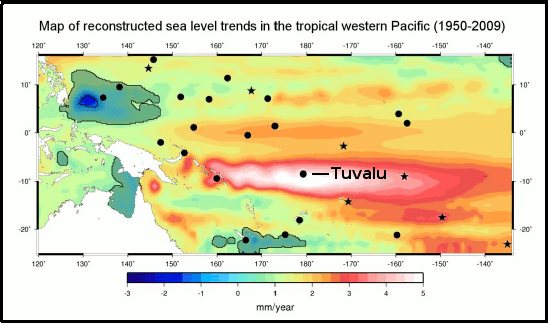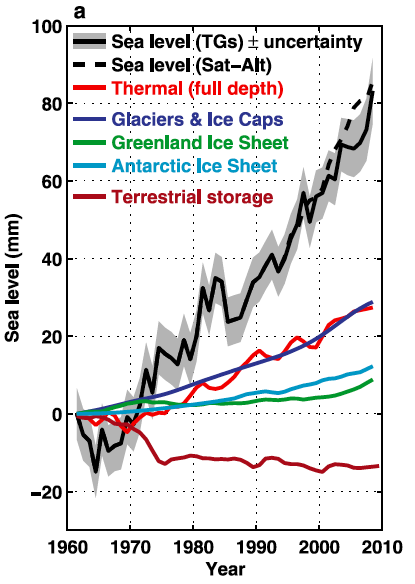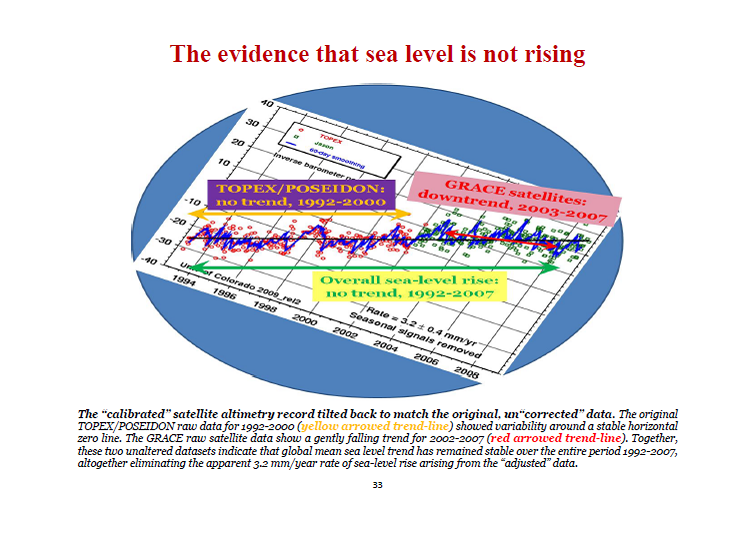Nils-Axel Mörner is Wrong About Sea Level Rise
Posted on 6 December 2011 by dana1981
The Spectator has published an article written by Nils-Axel Mörner with his usual denial about sea level rise (which has been re-published by many of the usual suspects). Figure 1 shows the mean global sea level data whose accuracy Mörner denies:

Figure 1: University of Colorado global mean sea level time series (with seasonal signal removed)
Mörner claims that the "true experts" think this data is wrong (emphasis added):
"The world’s true experts on sea level are to be found at the INQUA (International Union for Quaternary Reseach) commission on Sea Level Changes and Coastal Evolution (of which I am a former president), not at the IPCC. Our research is what the climate lobby might call an ‘inconvenient truth’: it shows that sea levels have been oscillating close to the present level for the last three centuries. This is not due to melting glaciers: sea levels are affected by a great many factors, such as the speed at which the earth rotates. They rose in the order of 10 to 11cm between 1850 and 1940, stopped rising or maybe even fell a little until 1970, and have remained roughly flat ever since."
This is quite different from the INQUA official position on climate change, which opens by saying (emphasis added):
Climate change is real
There is now strong evidence that significant global warming is occurring. The evidence comes from direct measurements of rising surface air temperatures and subsurface ocean temperatures and, indirectly, from increases in average global sea levels, retreating glaciers, and changes in many physical and biological systems. It is very likely that most of the observed increase in global temperatures since the mid-twentieth century is due to human-induced increases in greenhouse gas concentrations in the atmosphere (IPCC 2007).
As George Monbiot has documented, INQUA has been trying to dissociate itself from Mörner's views.
Current president of the INQUA commission on Coastal and Marine Processes, Professor Roland Gehrels of the University of Plymouth, says his view do not represent 99% of its members, and the organisation has previously stated that it is "distressed" that Mörner continues to falsely "represent himself in his former capacity."
Tuvalu is among the various individual locations Mörner focuses on in his attempt to distract from global sea level rise. However, it is a rather poor choice, since sea level rise around Tuvalu is faster than the global average (Figure 2).

Figure 2: Map of the Pacific Island region interannual sea level trend (linear variation with time) from the reconstruction 1950-2009. Locations of the 27 tide gauges (black circles and stars) used in the study are superimposed. Stars relate to the 7 tide gauges used in the global reconstruction. Dark areas relate to non-significant trends. From Becker (2011).
So how does Mörner explain the global sea level rise record, in which both satellite altimeters and tide gauges show average global sea level rise on the order of 3 mm per year (Figure 1)? It's all a conspiracy, of course:
"In 2003 the satellite altimetry record was mysteriously tilted upwards to imply a sudden sea level rise rate of 2.3mm per year...This is a scandal that should be called Sealevelgate. As with the Hockey Stick, there is little real-world data to support the upward tilt. It seems that the 2.3mm rise rate has been based on just one tide gauge in Hong Kong"
Obviously this conspiracy theory is utterly absurd, and is easily disproven by simply examining the IPCC Third Assessment Report (TAR) published in 2001, two years before Mörner's accusation of falsified sea level data, which shows an approximately 10 to 15 mm rise in average global sea level from 1993 to 1998 (Figure 3).

Figure 3: Global mean sea level variations (light line) computed from the TOPEX/POSEIDON satellite altimeter data compared with the global averaged sea surface temperature variations (dark line) for 1993 to 1998. The seasonal components have been removed from both time-series. (IPCC TAR)
In short, Mörner's conspiracy theory and accusation of falsified data is complete nonsense. It's also ironic that Mörner accuses others of falsifying data, since he has previously doctored photographs in his own presentations (i.e. see multiple photos of the Maldives 'marker tree' spliced together here and here).
However, even if we disregard the satellite altimetry data and instead examine the tide gauge data that Mörner prefers, his assertions are still clearly false. Church and White (2011) examined sea level data from both tide gauges (TGs), satellite altimeter data (Sat-Alt), and the estimated contribution to the sea level rise from various sources (Figure 4). The net estimated mean sea level rise from tide gauges and satellites is essentially the same.

Figure 4: The observed sea level using coastal and island tide gauges (solid black line with grey shading indicating the estimated uncertainty) and using TOPEX/Poseidon/Jason?1&2 satellite altimeter data (dashed black line). The two estimates have been matched at the start of the altimeter record in 1993. Also shown are the various components contributing to sea level rise (Church and White 2011)
Rather than being flat since 1970, as Mörner claimed in The Spectator article, mean sea level has risen more than 80mm over that period, according to tide gauges. In fact, not only is global mean sea level data rising, but the rise is accelerating.
Highlighting the degree to which his arguments are divorced from reality, in testimony to the British House of Lords, Mörner even presented this laughable graph (which was later reproduced by Monckton and the SPPI), simply rotating Figure 1 to produce "the evidence that sea level is not rising" (Figure 5).
Figure 5: Tilted global sea level data produced by Monckton and Mörner in the SPPI Monthly CO2 Report for January 2011
Nils-Axel Mörner's claims regarding sea level rise are the very definition of denial, involving nothing more than conspiracy theories and unsubstantiated accusations of data falsification wich are easily proven untrue. The mainstream media needs to realize that Mörner is simply not a credible source of information about sea level rise or climate science in general. One individual's unsupported conspiracy theories do not trump empirical observational data.
Note: this is the Intermediate level rebuttal to the myth Sea level is not rising































 Arguments
Arguments































[DB] Not quite. This post is on Nils-Axel Mörner is Wrong About Sea Level Rise, not on your predilection for ignoring the totality of the data by focusing on cherry-picked periods of time too short to rise to the level of statistical significance. As such, your comment was OT.
He's back: http://www.eike-klima-energie.eu/fileadmin/user_upload/jaeger/Moerner_Parker_ESAIJ2013.pdf
Present-to-future sea level changes: The Australian case
Published in "Environmental Science, An Indian Journal" ISSN : 0974 - 7451 Volume 8 Issue 2
AndrewMF @47, the reported sea level rises by the Australian Baseline Sea Level Monitoring Project (ABSLMP) are measured by SEAFRAMEs (SEA-level Fine Resolution Acoustic Monitoring Systems), as illustrated below:
Two important features are the GPS system (CGPS) and satellite telemetry antenna used to check for subsidence or uplift of the pier on which the seaframe monitor is built. Also important is the barometric pressure sensor. Australian SEAFRAMEs include an additional downward facing radar to monitor the distance between the pier and the wave surface.
The reported sea level rises from the ABSLMP included adjustments for subsidence and uplift and (importantly) reverse barometric pressure. The later is important because Morner claims the ABSLMP reports ignore the effect of the transition from the 1998 El Nino to generally La Nina conditions over the last few years, a transition which would raise the directly measured sea level. However, that effect is a consequence of reduced barometric pressure in Australia in La Nina conditions, and so is directly accounted for with the inverse barometric pressure adjustment (and explicitly discussed in ABSLMP reports).
In prefference to measurements from this system, Morner suggests we take the average trend over different time periods of several stations (inaccurately reported as an average trend since 1900); or the average over different time periods from a non-geographically representative set of tide stations. He also insists we take the average since 1900.
The ABSLMP has been in operation since 1991. If Morner was going to use the other tide station data to check its accuracy, he would report the trends since 1991 where available. By not doing so, he makes an apples an oranges comparison. It is quite possible that the average sea level rise since 1900 show a trend of 1.5 mm/year (as reported by Morner) but that the ABSLMP correctly report a recent rise of approx 4.88 mm/year to June 2011 (taking the average from the start data of different tide gauges which range from May 1990-Sept 1993, hence not quite accurate)
Finally, Morner attributes a claimed rate of sea level rise for Australia to the Australian Climate Change Commission. I am unable to find a source of that claim. The report cited by Morner claims a 3.2 mm per year global rise based on satellite data, and the average of the Australian stations shown (in figure 8) is just 4.3 mm per year (to 2008, with the same caveat about start dates). Absent evidence to the contrary, it appears Morner has set up a strawman.
I forgot to link to the Australian Climate Commission Report cited by Morner.
Thanks Tom!